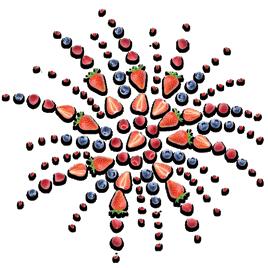





ENJOY ALL THE HOLIDAYS HAVE TO OFFER WITH OUR BLEND OF ENERGIZING INGREDIENTS AND RESEARCH-PROVEN NUTRIENTS.
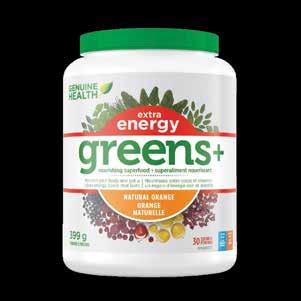


PREVENT COMMON COLDS, FLUS AND VIRUSES AND BOUNCE BACK FASTER WITH THIS POWERFUL PROBIOTIC BLEND.
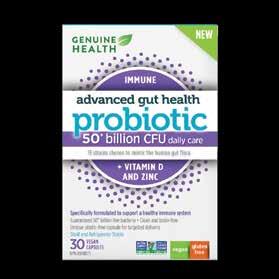
15 Oh my Gourd!
Recipes: Pumpkin Coffee Cake Butternut Squash Gnocchi with Sage & Thyme Brown Butter Sauce


21 Easy Lunchbox Prep: Homemade Sandwich

SPECIAL EVENT & SALE
Celebrate 30 years of wellness with us with 30 days of giveaways. Join the festivities all month long.
• Enter to win $30,000 in prizes like kayaks, e-bikes and barbecues—or the grand prize of groceries for a year. Visit naturesfare.com for details.
WHEN : September 1–30
Save big throughout the store on organic produce, premium supplements, clean personal care, quality groceries and delicious Bistro items.

WHEN : September 21–23
WHERE : All Stores

LET’S TALK: GUT HEALTH
Orsha Magyar from Botanica will help you to discover what three simple nutrition habits can help improve your overall mental and physical health plus support brain health as you age.
SPEAKER : Orsha Magyar
WHEN & WHERE :
October 3 | Kamloops
October 4 | Vernon
October 5 | West Kelowna
MORE EVENT DETAILS: naturesfare.com/upcoming-events
The health and wellbeing of our customers is central to our mission. We believe that learning how to live your healthiest life should be accessible to everyone. That’s why our Wellness Talks are made available for free to everyone.
Dates subject to change.
Marketing Director Stephanie Thatcher
Content Manager Chantelle Nuttley
Creative Director Janna Payne
Copy Editor Marilyn Fransen
LET’S TALK: HORMONES
Join Aeryon Ashlie from Aeryon Wellness and open up to the small lifestyle changes of biohacking that can naturally rebalance your hormones—and help you enjoy better sleep, moods, focus and more.
SPEAKER : Aeryon Ashlie
WHEN & WHERE :
October 3 | Kelowna
October 4 | Penticton
October 18 | White Rock
October 19 | Langley
LET’S TALK: PLANT MEDICINE
With naturopathic doctor and registered herbalist Dr. Briana Lutz from St. Francis Herb Farm discover which herbs and formulas are best for preventing colds and the flu, and which to take at the first sign of symptoms so you can bounce back sooner.

SPEAKER : Dr. Briana Lutz
WHEN : October 24
WHERE : Instagram Live
Missed an event?
Check out our YouTube channel to catch up.
@naturesfaremarkets
SUPPLEMENT
What can help keep you healthy through cold and flu season? With antiviral, antibacterial and antifungal properties, Essential Silver™ is nature’s effective defense against germs. Since we don’t get enough silver in our food, a daily dose of Essential Silver Premium Ionic Silver can boost your immunity and act as a powerful flu fighter. It’s tasteless and easy to fit into your routine—or take it at the first sign of a sore throat or sniffles.
Jardine Naturals Essential Silver Premium Ionic Silver

SUPPLEMENT
Who says you can’t wear a smile while you’re cleaning? The eco-friendly Swedish Cloths from Ecologie bring a bit of wit and whimsy to your kitchen with vibrant colours and patterns—from cats and llamas to lemons and ladybugs. The new collection, styled by Canadian designers, is also uber functional. These super-absorbent, reusable cleaning cloths triple as sponge, dishcloth and power towel. Whatever the mess, this is the cloth to count on!

Ecologie Swedish Cloths






Have you been on the fence about trying leak-proof underwear? What should you look for in 12-hour undies that are good for you and the planet? Revol Cares briefs and bikinis are made to be washed 100+ times so you can get up to four years of reusable wear. That’s not all. Made with an ultra-soft, breathable bamboo fabric, they’re luxuriously comfortable and lock in odours, even after 12 hours. Plus, they’re free of chemicals and come in cute, compostable packaging.

Revol Cares Briefs and Bikinis
 Made in BC
Made in BC
After months of construction in 1993, when Nature’s Fare Markets opened its doors on Cooper Road in Kelowna, it was unlike anything else: the store was a hub for innovative, grassroots wellness culture, but it also had the hallmarks of mainstream retail shopping, with a large selection and Fare Points. The store was also building something else that was just as special and unique: a community of people—local farmers, incredibly passionate team members and loyal customers. It’s where people are always first. For Nature’s Fare Markets, it’s these connections, values, relationships and meaningful memories that have come together to tell a beautiful story.
 2023: At the Kamloops store (left to right): Stephanie Thatcher Director of Marketing, Michael Sherwood
2023: At the Kamloops store (left to right): Stephanie Thatcher Director of Marketing, Michael Sherwood
The sun breaks over the hills, the streets, the loading dock in the alley. The farmer is here in his pickup truck, with today’s drop of kale, corn or peaches. The produce manager is here, wearing gloves, an apron and a smile. Wooden bins of fruit and vegetables are stacked while they chat about their crops and families.
One of Brooke Sproule’s fondest teenage memories is the three times weekly drops of cherries at the back door of Nature’s Fare Markets in Kelowna. She was 16, had just earned her licence, and she loved driving, Okanagan mornings and those smiles at the loading dock.
“We knew everybody and they were so excited to get our fruit,” says Brooke. She’d help unload the crates and then drive around front to go inside and pick up whatever groceries were on her mom’s list. That was nearly 15 years ago, and now the Oyama orchard started by her grandparents in 1946 is a certified organic fruit farm of 10 acres run by Brooke and her husband Tanner.
Brooke has been able to carry on this legacy and dream for her own family in part because of this “partnership” with Nature’s Fare Markets.
“I’m always so thankful that my parents fostered that relationship,” says Brooke. Her parents had become close with the store’s founder, Rick Monahan, who arrived in the Okanagan in the early
‘90s with the dream of making a health-conscious lifestyle accessible to everyone.
Randy Irwin remembers those early mornings out back with Brooke and the others from family farms like hers, the pickup trucks piled high with carrots and lettuce and the bread so fresh it was still hot and steaming. After a few months working in produce in 2000, Randy was soon promoted to produce manager at the Kelowna store. “All of this became very much a passion and a foundation for me. I loved connecting with the farmers. I loved the relationships.”
By then the Kelowna store had been open for six years, after construction began in 1993. It was about 2,000 square feet and centred around what Randy called “a core group of customers” who lived that lifestyle: drinking rice milk in their fair trade coffee and taking turmeric to limber up their joints for weekend paddles or hikes.


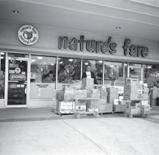
“Nature’s Fare was the only place to find things like dairy alternatives back then. And we always had a strong local produce program. We were connected to our farmers and the local food chain at a time when most people didn’t think about where that box of food came from to get to the grocery store.”

“It’s mind-boggling to me to see how far we’ve come,” says Jodi Harries, who is now a part of a commissary team of 25 people based in
the Vernon building that includes the warehouse, HR, marketing and more. She was hired in 2009, when the commissary was still in the small kitchen of the Vernon store that had opened in 1996, and there were just six people on that team, squeezing citrus, stirring fresh applesauce, roasting chicken breasts, washing their own dishes.
“I think what still excites me is there is always something new to learn, and the friendships that I have made along the way. Nature’s Fare is like family to me—I’ve met so many great people.”
Team members dig in, and they dig in big.
Laurie Yakelashek remembers a turn of events in her life that saw her shift from plans to become a Mountie to showing up at the old Eaton’s department store building in Vernon, where she’d worked in high school, after noticing a help wanted ad for Nature’s Fare. Resume in hand in the store, she ran into people she’d known as a teenager; a manager knew one of her uncles. Within hours, she was in and “it felt right…it felt like I was a part of a work family.”
That meant pitching in and being glad to have the chance to help out.
“I would become a receiver on the fly, build grocery pallets in our receiving area to ship to our stores…and help out in the Bistro in a pinch.”
Continued on next page
Kelowna Vernon Kamloops PentictonWhat she has also loved has been the chance to be a part of community causes, such as the local food bank or the adult spelling bee in support of childhood literacy, or Gleaners in Lavington, which makes dehydrated vegetable soup to help feed the world’s hungry. Indeed, Nature’s Fare is known for its community generosity. In 2022, as so many BC families were struggling to recover from the effects of the pandemic, the seven Nature’s Fare stores collected more than 12,000 pounds of food bundles donated by customers and donated $60,000 to six Food Banks.
Today, Laurie is one of the produce specialists who gets to nurture relationships and new possibilities with certified organic local farms, like Sproule and Daughters in Oyama, Two EE’s Organic Produce in Surrey and Amazia Farms in Oliver.
Three times a week in the warm months, Mike Kosaka of Amazia Farms pulls up to the back of the Penticton store with vegetables he and his wife and children have picked just the day before: arugula, beets, chard, kale and lettuce mixes.
We won CHFA Retailer of the Year in 1997 and have won four more times since.
In the course of year, it adds up to nearly 10,000 bunches of kale, 2,000 pounds of garlic, 7,000 bags of arugula, to name a few.
“We have to be competitive with things coming out of Mexico or California, but we’re given a privileged position because the whole chain lives the commitment of supporting local,” says Mike.
Local and fresh. Field to table in just a day or two. In fact, at the peak of growing season, 75 percent of the store’s organic produce is locally grown and Nature’s Fare has relationships with 75 growers, making that possible.

“Everything is so fresh,” says Mike. They meter out what Nature’s Fare needs and plant and plan to cut lettuce, for example, three times a week so the veg can get to the customer as quickly as possible. Interstore trucks that go through a network up from Penticton to Kamloops stores (the third and fourth stores, which opened in 1998) also make selling in this way viable for a small family farmer. That and getting paid the week after
We are Climate Smart certified in 2013 and granted B Corp certification in 2014.
the kale and the chard has been scooped off the shelf by customers.
“You can count on them to always come through.”
And that’s true whether farmers— and other vendors—want to stick with what’s tried and true, or try something new.
A few years ago, Brooke had the idea of flash-freezing the Sproule orchard’s peaches and supplying frozen peaches to Nature’s Fare year-round.
“They said, ‘OK, we’ll try it,’ and that’s been life-changing for us,” says Brooke. Now the Bistro at all stores makes smoothies with these frozen peaches. The commissary, too, uses Sproule peaches for a decadent chutney.
Randy says that commitment to people and farms and innovation has allowed Nature’s Fare to continue to be leaders of the pack— and a grocer of choice, now in cities that include Langley (opened in 2010) and White Rock (the seventh store, opened in 2016).

2009 Commissary & Events

A Commissary kitchen is added at our corporate office to support our Bistros. We begin hosting wellness events in stores.
2013 Nutritionists
We offer complimentary nutritionist consultations.
2003
3% Club
We donate 3% of member purchases to nonprofits. Other programs, like Save-a-Bag and Brilliant Brains Book Club, been added since.
2008
West Kelowna
Our 5th store opens.

2010
Langley
Our 6th store opens— the first in the Lower Mainland.
West Kelowna Langley 1995: Kelowna store 1st Anniversary 1995: A Kindergarden class gets a tour of the Kelowna store to learn about food“Watching our vendor partners grow and these farmers develop these speciality niche products, it’s amazing to see the incredible innovation just within this tightknit group of people.”
Today, late July, the Sproules are just waiting for their peaches to ripen. In the meantime, if they have extra cherries or nectarines, Brooke can phone up the Vernon store’s produce manager and ask about taking extra and doing a sale, and they’ll probably say yes. Like most summers, Laurie will probably be by the orchard for a visit, and say hello to the newest Sproule.

In the farmhouse where she grew up and now raises her children hangs a 20-year-old family photo framed in barnwood. Brooke, on one end, is a teenager, alongside her brother, sister, mom and dad, whose head is just below the Nature’s Fare Markets logo. Behind them are the peach trees about to bud, and Wood Lake. Their hands brush the words overlaid in white script: Committed to Buying Local.
“I just love how it feels like a family. They want the best for us, is how I truly feel. They’re invested in us and our story.”
Some 130 kilometres away from the Sproule orchard, at the brand new Nature’s Fare Markets store in Kamloops on Notre Dame Drive, a woman in shorts orders the Joyful smoothie with peaches at the smoothie bar.
The store opened in July in what was once a Toys ‘R’ Us—doubling the size of the Nature’s Fare store on Summit Drive to nearly 20,000 square feet. With all that room and fresh, modern branding came the opportunity to bring in even more organic fruits and vegetables from dozens of BC growers, and also the chance to try new things: a ‘fresh bar,’ where customers can build their own salads or a meal with mac and cheese or vegan lentil bolognese; a speciality coffee bar where you can get a latte topped with collagen or turmeric; café seating for 35; a low waste refill section for everything


from loose-leaf tea to household cleaners; and a bakery, a first for Nature’s Fare, featuring artisanal breads, decadent cakes and pastries to suit a variety of diets.
“We have so many great customers in Kamloops,” says CEO Michael Sherwood. “They have busy, active lifestyles and families, and they care about shopping local, organic and sustainable—so it was exciting for us to meet that growing demand and let them experience all of these new and enhanced offerings.”
While Kamloops customers are showing the ambience and ‘bars’ are a hit, with customers taking selfies in the aisles, what remains is something you’ll find at any Nature’s Fare store: a coziness created by a family of team members and customers passionate about health and wellness and local growers.


“At the end of the day what draws customers to us is our team members,” says Sherwood. “We strive to provide a great customeremployee experience, and I’m sure that over the next 30 years, we’ll continue to ensure this remains our hallmark.”
 White Rock
Penticton
Kamloops
2018: new Penticton location Grand Opening
White Rock
Penticton
Kamloops
2018: new Penticton location Grand Opening
Ah the ‘90s. The decade of Gen Xers, rollerblades and Doc Martens. The rise of New Age spiritualism, gay rights and blended families. Coffee culture reigned, people began driving SUVs and rocked to grunge and hip hop. And the internet transformed how we worked and lived.
This decade started viewing Health and Wellness as a lifestyle, as people embraced a more holistic approach to illness prevention, which continues today. To celebrate the 30th Anniversary of Nature’s Fare Markets, we’re looking back at wellness trends, products and tips from over the years, many of which are still relevant today.
1 Concern about food grown with synthetic fertilizers and pesticides, and health risks of processed foods, inspired a growing demand for natural and organic foods. A fringe movement became mainstream.
2 Vitamin and supplement sales boomed, seen as a form of preventive and alternative medicine.

3 Vegetarianism surged, fuelled by mad cow disease and growing awareness of the ecological impact of food production.
4 Organic coffee gained popularity as a healthier alternative to beans sprayed with synthetic chemicals.
5 Standardized nutrition food labels on packaged foods were mandated in the US, and Canada began the process, as we began to pay attention to the content of our food.
6 Low-fat diets were the rage, as people believed less fat led to weight loss and lower risk of heart disease. We now know better and embrace healthy fats for brain health, energy, cell growth, nutrient absorption and to control cholesterol and blood pressure.
7 Eating enough protein and limiting carbs became the new way to eat healthy, lose weight and ward off cardiovascular and other diseases.
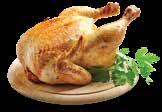
8 Textured vegetable protein became popular as a proteinrich, low-fat meat alternative and really hit mainstream with the launch of the Gardenburger®.
9 Healthy snack foods like low-carb shakes, chips, bread, no-sugar desserts, and other products crowded store shelves.

10 The term “wellness” became a buzzword, first defined in the ‘50s as “an integrated method of functioning which is oriented toward maximizing the potential of which the individual is capable”.
11 People began to talk about the mind-body connection: how our thoughts, feelings, attitudes and beliefs affect our biological functioning.
12 Mental health. Between 1987 to 1997, people receiving treatment for depression (in the US) rose more than 300 percent. Anti-depressant and -anxiety medication sales boomed.
13 Stress was acknowledged as a major contributor to a variety of health problems. People were encouraged to find ways to reduce stress through activities like yoga, meditation and exercise.

14 Regular exercise through fitness classes and gym culture boomed, pumped by sciencebased information about the benefits to heart health, a healthy weight and reducing the risk of chronic diseases. Athleisure as fashion followed.
15 Wellness retreats. As an antidote to intense work lives, now-ubiquitous retreats linked escape with healthy food and physical and self-care improvement. Beach yoga and vision boards, anyone?
16 Meditation. Although thousands of years old, the popularity of meditation and mindfulness-based cognitive therapy took hold to help us to create new, healthier thought patterns.
17 SPF. With growing skin-cancer awareness and the role of harmful UV rays in premature aging, most sunscreens began to carry SPF information. Today SPF is found in a wide range of products from lip balm to foundation, with kinder-to-water wildlife formulations.
18 Bottled and filtered water became popular because of concerns of contaminated water supply, the rise of the fitness industry and a desire to stay hydrated.

19 The first clean and natural crystal deodorant offered an alternative to aluminum- and chemical-based formulations.
20 In 1994, Dr. Andrew Weil, pioneer of integrative and holistic health, founded the first Integrative Medicine program. This launched an evidence-based approach to treat the whole person—physically, emotionally, mentally and spiritually—using conventional and complementary therapies to achieve optimal health and healing.
21 In 1992, Canada’s federal government launched the first breast cancer screening program.
22 Biodegradable cleaners, conditioners and colour-safe bleach hit the shelves.
23 We got wise on artificial and processed sweeteners. While saccharin and aspartame where dubbed the healthy alternative we now know the health risks and saw a return to naturally sourced lower glycemic sweeteners like coconut sugar and honey.
24 Canada passed legislation making it illegal for people under 18 to smoke cigarettes, followed by a requirement for warning messages about addiction and health risks on packaging.
SOURCE
https://www.thecanadianencyclopedia.ca/en/article/ genetically-modified-foods https://croplife.ca/field-notes-gmo-foods/ https://en.wikipedia.org/wiki/Halbert_L._Dunn https://www.betternutrition.com/features/better-nutrition1990s-part-1/ https://www.betternutrition.com/celebrating-80-years/ better-nutrition-in-the-1990s-part-2/ https://www.health.harvard.edu/staying-healthy/know-thefacts-about-fats
25 New life-saving anti-viral drugs, created to treat HIV/AIDS and hepatitis, were introduced in 1987.


26 GMO/non-GMO foods. Breakthroughs in biotechnology brought the first genetically modified Flavr Savr tomato to market. As other crops were commercialized, concerns arose for our health and the environment, and a demand for transparent food labelling and non-GMO options.
27 In 2004 new Natural Health Product (NHP) regulations were introduced, adding even more efficacy to the high quality supplements sold in Canada.
28 With the birth of the World Wide Web, the internet became the primary source for information about everything.

29 The first cell phones capable of email and downloading debuted, giving people the freedom to access information anywhere, anytime and for the myriad medical and health apps we use today.

30 The first phone app was released in 1997. It wasn’t long before phones were able to hold a myriad of tools to help us on our health journey such as source nutrition and product information or guide us though a workout or meditation—all with just a few taps!
https://www.redbookmag.com/body/pregnancyfertility/g4283/what-birth-control-was-like-in-everydecade/?slide=10
https://www.encyclopedia.com/history/dictionariesthesauruses-pictures-and-press-releases/health-foodindustry https://www.thespruceeats.com/most-important-foodmoments-90s-timeline-6399309 https://www.encyclopedia.com/social-sciences/culturemagazines/1990s-lifestyles-and-social-trends-topics-news

https://elemental.medium.com/the-obsession-with-wellnessretreats-goes-back-centuries-5c491cf2baa3 https://en.wikipedia.org/wiki/1990s_in_science_and_ technology https://www.eatingwell.com/longform/7836258/nutrition30-years/ https://positivepsychology.com/mbct-mindfulness-basedcognitive-therapy/ https://www.canada.ca/content/dam/phac-aspc/migration/ phac-aspc/cd-mc/publications/cancer/obcsp-podcs05/pdf/
breast-cancer-report-eng.pdf
https://www.lovetoknow.com/home/cleaning/laundrydetergent-history https://www.ncbi.nlm.nih.gov/pmc/articles/PMC2888013/ https://www.encyclopedia.com/social-sciences/culturemagazines/1990s-medicine-and-health-chronology https://www.androidauthority.com/history-of-cell-phonestimeline-3264425/

Have you ever wondered what exactly is a whole food? Is it just fruit and veggies? Or does granola count?

Whole foods usually aren’t packaged or have ingredient lists because they are the ingredients.
At its core, a whole food refers to an unprocessed food as close to its natural state as possible. I think of whole foods as “ingredients”. They usually don’t contain packaging or ingredient lists because they’re the ingredients.
Whole foods haven’t been stripped of their nutrients or altered with artificial additives. Instead, they retain all their original goodness, including vitamins, minerals, fibre and phytochemicals. Think fresh fruits and vegetables, whole grains, legumes, nuts, seeds and lean proteins.
But here’s the thing—processing isn’t always a bad thing. Cooking and even chopping up your vegetables are considered a form of “processing”. But there are different levels of processing to consider.
Minimally processed food is another very important category, and I would argue that these foods are as healthy (and sometimes healthier) as 100% whole foods. Minimally processed foods are a little different than what’s found in nature, but not much. They can be frozen berries or vegetables (which are often more nutritious than their fresh counterparts), canned beans or veggies, or food made from whole food ingredients, like granola. Cooking, fermenting and at-home canning also fall into this category.
What’s gotten a bad reputation, and for good reason, are highlyprocessed or ultra-processed foods. Think about the running joke about Twinkies®, that they’ll outlive the human species. This is because they’re so highly processed that they no longer contain anything that you can recognize as food. Ultra-processed foods are made from highly-processed ingredients, like refined flour, high fructose corn syrup and preservatives. There’s a good chance you’ll find chemical names (glucose/fructose) and names that include numbers (like yellow #5) in the ingredient list.
So, why opt for whole foods over heavily-processed alternatives? The answer lies in the nutritional value they offer. Whole foods are packed with essential nutrients your body thrives on. They provide a balanced combination of macronutrients (carbohydrates, proteins and fats) and micronutrients (vitamins and minerals) in forms your body can easily recognize and utilize. By consuming whole foods, you fuel your body with the nutrients needed for optimal health and vitality.
It can be easy to create a “good” list of whole foods and a “bad” list of Twinkies and other ultra-processed food. But this isn’t necessary and can lead to feelings of deprivation and restrictive eating. Real health is found in the grey area.
1 DO read the ingredient list
Look for foods with short, recognizable ingredient lists. If you can’t pronounce an ingredient or it sounds like a chemical experiment, that’s a food to “squish out” with more whole foods. The best are foods without any ingredient lists (like an apple).
2 DO watch out for added sugars
Scan the ingredient list for sneaky sugar aliases such as high-fructose corn syrup, maltose or dextrose. The closer these ingredients are to the top of the list, the more sugar the product contains.
3 DO prioritize real ingredients
Look for real, whole ingredients. For example, choose peanut butter made from just peanuts rather than those loaded with added oils, sugars and preservatives.
1 DON’T fall for marketing claims
Be sceptical of claims like “all-natural”, “fat-free” or “low-calorie.” These terms can be misleading and may not accurately represent the nutritional quality of the product.

2 DON’T ignore order of ingredients
Pay attention to the order in which ingredients are listed on the label. Ingredients are listed in descending order by weight, so if processed ingredients like sugar or refined oils are listed at the top, it’s a red flag that the product may not be as wholesome as it claims to be.
3 DON’T rely solely on package claims
Don’t be swayed by attractive packaging or flashy labels. Often, the real story lies in the fine print on the back.
4 DON’T disregard artificial additives
Be cautious of foods that contain artificial additives, such as artificial colours, flavours and preservatives. These can have negative effects on health and are often found in ultraprocessed foods. Choose products with minimal or no artificial additives whenever possible.















Time to make: 1 hour
Serves: 9
Wet Ingredients
2 tbsp flax meal
6 tbsp water
⅓ cup coconut oil, melted
¾ cup pumpkin purée
¼ cup maple syrup
Dry Ingredients
1 ½ cups almond flour
1 cup brown rice flour
½ cup oat flour
½ cup coconut sugar
Cinnamon Filling
¼ cup vegan butter, melted
1 tsp cinnamon
¼ cup strong coffee, cooled
1 tsp vanilla
½ cup plant-based milk, room temperature
1. Preheat the oven to 350°F and line an 8" x 8" square pan with parchment paper.
2. Prepare the flax egg. Add 2 tbsp of flax meal to a small bowl with 6 tbsp of water and stir. Set aside for 5 minutes to thicken.
3. Melt the coconut oil then set aside to cool.
4. Add the flax egg, coconut oil, pumpkin, coffee, maple syrup, vanilla and milk to a large bowl and whisk together.
5. Add all the dry ingredients together in a separate bowl and whisk together.
1 tsp baking soda
1 tsp baking powder
1 tsp cinnamon
1 tsp pumpkin pie spice
pinch of salt
¼ cup coconut sugar
6. Add the dry ingredients to the wet ingredients and mix together just until no more flour is visible. The batter will be thick and smooth.
7. Prepare the cinnamon filling. Melt the butter and add to a small bowl. Add the coconut sugar and cinnamon and stir together.
8. Pour about half of the batter into the pan. Use a spatula to spread the batter into an even layer. Spread half of the cinnamon filling evenly on top. Add the rest of the batter and smooth out. Top it with the rest of the cinnamon filling.
9. Bake for 45 minutes. Cool completely before slicing. To serve, cut into 9 squares.
10. Store leftovers in a sealed container up to 5 days.


Time to make: 50 minutes
Passive time: 2 hours
Serves: 2
Gnocchi
1 small butternut squash
2 tsp oil (divided)
1 small potato
1 cup brown rice flour
½ tsp salt
Sauce
4 tbsp vegan butter
2 cloves garlic, finely chopped
2 tbsp fresh thyme
6 sage leaves, plus more for garnishing salt and pepper
1. Preheat the oven to 400°F. Cut the butternut squash lengthwise down the middle. Remove the seeds. Lightly oil the cut side of the squash and lay face-down on a baking sheet. Bake for 30–40 minutes or until a fork can easily pierce the squash.
2. Bring a medium pot of water to a boil. Peel and cut the potato into medium-sized cubes. Add to the boiling water. Cook for 10 minutes or until fork tender. Drain and mash. Set aside to cool.

3. Peel the skin off the cooked squash. Add to a food processor and blend until it’s a smooth purée. Let cool and then measure out 1 cup. (Reserve any extra squash for another use.) Add to a bowl with the potato, brown rice flour and salt. Mix together, using a spoon and then using your hands to knead. If the dough is dry, add more squash. If the dough is too wet, add flour.
4. Divide the dough into four equal pieces. Sprinkle flour on your work
surface. Gently roll each piece into a rope about 2" thick. Cut into ½" wide pieces. Lightly coat the pieces with flour and place on a parchment-lined baking sheet. When all the gnocchi is formed, refrigerate for 1 hour.
5. Bring a large pot of water to a boil and preheat the oven to 350°F. Add the gnocchi to the boiling water. Gnocchi is done when it floats to the top. Remove the gnocchi with a slotted spoon and transfer to a parchment-lined baking sheet.
6. Once all the gnocchi is cooked, lightly drizzle with oil. Bake for 15–20 minutes, flipping over halfway.
7. While the gnocchi is baking, prepare the sauce. Add the butter to a pan over medium-low heat. Once it’s melted, add the garlic. Cook for 1–2 minutes then add the thyme, sage and salt. Continue cooking for roughly 5 minutes, stirring occasionally.
8. Lightly toss the gnocchi in the sauce and serve immediately.
IG: @greenseggsandyams
Robin is the creator of the blog Greens, Eggs and Yams. Her passion is creating vegan and gluten-free foods that don’t compromise on taste. She loves being in the kitchen, creating recipes that everybody can enjoy!








It’s that time of year again! Time to trade in the flip-flops and tank tops for sneakers and backpacks. As we get ready to send our little ones back to school for another year, we arm them with all the school supplies they need, neatly tucked into that new backpack. We make a special event out of back-to-school clothes shopping and be sure to fit those growing feet with larger shoes.
But have you ever wondered if there was anything else you could do to support your child’s needs?
What about their nutrition? What healthy foods should you fill their lunch kit with that will not only taste great but also support the needs of their growing brain?

Getting proper nutrition is essential for healthy brain function—regardless of whether we’re 8 or 88. So if you’ve ever wondered how best to keep your child’s mind sharp or improve their cognitive function, you’ll want to pay attention as we explore how to feed your child’s brain.
There’s no question that what we eat plays a major role in not only
how we feel but our moods and behaviour. The same goes for our kids.
Studies consistently show that children who eat diets containing more fruit and vegetables have better mental health and wellbeing than those who don’t. And children whose diets contain little to no nutritional value, like those containing excess saturated fat, refined carbohydrates and processed or deep-fried foods, are more likely to experience poor mental health, reduced resiliency and behaviour issues.
Excess sugars, artificial food dyes, flavour enhancers and ultra-processed foods are most likely to blame, especially when consumed by children sensitive to any of these compounds or those who are neurodiverse.
When children have sensitivities or allergies to certain foods, it can manifest as mood disturbances or behaviour issues. Common culprits include gluten, dairy, artificial additives and food dyes. Identifying and addressing these sensitivities can go a long way in alleviating mood-related symptoms and promoting emotional well-being.
Moreover, additives and refined sugar rob a growing brain of the nutrients it needs to thrive!
Knowing that foods can change a child’s brain’s chemistry and function, focusing on the best ones—those that support positive moods, improve well-being and encourage healthy minds at any age—is essential!
Whole foods for the win!
Some of the best foods to feed your child’s brain include a variety of nutrient-dense whole foods that contain ample protein and various vitamins and minerals to support the overall health of our children as well as the health and function of their brains.

Protein Protein stabilizes blood sugar levels to stabilize moods, boosts concentration, improves mental clarity, increases brain energy and provides the necessary building blocks for proper brain health. So, regularly incorporating protein-rich foods into your child’s diet is crucial. Some tasty options include fish, chicken, turkey, grassfed beef, beans, raw nuts, cheese, and high-protein vegetables like broccoli and spinach.


Eggs Pasture-raised eggs contain protein and healthy fats the brain loves, like choline and omega-3 fatty acids. A hardboiled egg or






two would make an excellent mid-day snack to keep your child’s brain sharp!
Berries Any berry makes the perfect brain food. They are loaded with antioxidants and vitamins that keep the brain sharp and improve communication between brain cells. Blueberries can also improve memory, so be sure to add a variety of delicious berries to your child’s diet.
Fish The omega-3 fatty acids in fish like salmon and mackerel are essential. They play a vital role in brain health by enhancing brain function, improving mood stability and fostering emotional resilience. Kids who don’t get enough omega-3s are more likely to develop depression or behaviour problems. If your child is not a fan of fish (I get it!), consider adding other forms of omega-3s to their diet, like walnuts, chia seeds and flaxseeds, or look into supplementation.
Fruits and vegetables We can’t discuss brain health without mentioning produce, as it offers multiple health benefits. You can’t go wrong with any fruits or vegetables. But if you have a picky eater, keep trying different ones until you discover some winners. And aim for fruits and vegetables of various colours, as each colour contains its own phytonutrient profile and can provide the essential vitamins, minerals and antioxidants your child needs to support their brain health and emotional stability.

Nuts and seeds Nuts and seeds are loaded with quality fats that help the brain function and keep it running at optimal speed. While all nuts are excellent, some of the best ones that support brain health are almonds, pistachios, walnuts, cashews, pecans, flax seeds, pumpkin seeds and hemp hearts.

Note: Because many schools are nut-free, they can make the perfect
 Natural turkey slices + cheese, pumpkin seeds and berries
Turkey, avocado and hummus wrap + fruit
Hummus + crackers, cheese, veggie slices and berries
Homemade chicken and vegetable soup + fresh fruit
Spaghetti squash and meatballs in tomato sauce
Tuna and chickpea wrap
Tuna salad lettuce wraps + apple slices
Hardboiled egg + cheese, veggie slices and fruit
Yogurt + sunflower seed butter, hemp hearts and apple
Avocado and beef quesadilla
Trail mix: raw nuts, pumpkin seeds, dried fruit and a little dark chocolate
Natural turkey slices + cheese, pumpkin seeds and berries
Turkey, avocado and hummus wrap + fruit
Hummus + crackers, cheese, veggie slices and berries
Homemade chicken and vegetable soup + fresh fruit
Spaghetti squash and meatballs in tomato sauce
Tuna and chickpea wrap
Tuna salad lettuce wraps + apple slices
Hardboiled egg + cheese, veggie slices and fruit
Yogurt + sunflower seed butter, hemp hearts and apple
Avocado and beef quesadilla
Trail mix: raw nuts, pumpkin seeds, dried fruit and a little dark chocolate
after-school snack at home or when you’re on the run. Make your own healthier trail mix by combining various raw nuts with pumpkin seeds, a few pieces of dried fruit and a little dark chocolate.
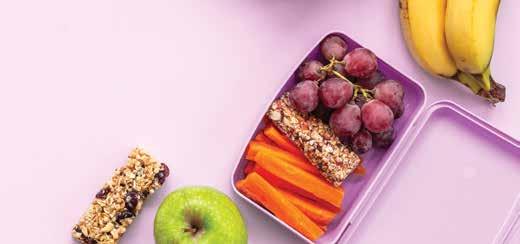
Luckily, there are many ways to incorporate these delicious, nutritious, mood-boosting foods into your child’s diet!
The options are endless! But the bottom line is if your child has difficulty paying attention or completing tasks, their mind wanders or they tend to misbehave, their nutritional status may be worth investigating.
Learn more: happihuman.com



Nutrient-dense whole foods are the key to supporting your child’s brain health.
We know how important a balanced diet is for our children’s growth and development. But we often overlook the profound impact that food choices can have on their mood, emotions and overall well-being.
By prioritizing their nutritional needs, we empower our children to thrive physically and emotionally, setting the stage for a brighter and happier future, as well as a productive school year!
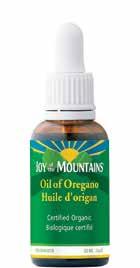


September is here and kids are headed back to school, which means back to packing lunches. It’s a job many parents and caregivers aren’t particularly fond of, but if your kids enjoy sandwiches, these prep-ahead, homemade sandwich pockets definitely make the process quicker and easier!



Pocket sandwich fillings should be freezer-friendly, but other than that, pretty much anything goes! Try these delicious combinations:
Sunflower seed butter + strawberry jam

Chocolate hazelnut spread + thinly sliced bananas + hemp hearts

Deli meat + cheese + mayonnaise or butter
Cream cheese + blackberry jelly
Tahini + maple butter + chia seeds
Pumpkin seed butter + agave + cinnamon
Prepare sandwich pockets in bulk and store them in the freezer. When it’s time to make lunches, pull them out and add them to your child’s lunch box still frozen… By lunchtime they’re defrosted and ready to enjoy!
soft, sliced sandwich bread (the squishier the better!) • fillings of your choice • sandwich sealer (or wide mouth mason jar ring/circle cookie cutter and fork)
1 Place two slices of bread on a cutting board. Use a sandwich sealer, mason jar ring or circular cookie cutter to cut the bread into circles. (Set the leftover crusts aside for another use.)

2 Spread toppings on each bread circle, leaving space around the edge.
3 Close the sandwich and gently press down. Flattening the sandwich will help prevent breakage when sealing.
4 Seal the edges of the sandwich with a sandwich sealer or use a fork or mason jar ring to crimp the edges shut gently but firmly. The softer your bread, the easier this will be!

5 Prep all your sandwich pockets then place in a single layer on a lined baking tray. Pop into the freezer for a few hours then transfer to an air-tight container and keep frozen until you’re ready to use for lunches.

The key to preventing your sandwich pockets from getting soggy? Slather both bread circles with butter, mayonnaise or cream cheese before adding wetter ingredients like jams, jellies or bananas. The spread works as a barrier to keep the bread from getting drenched.
Jen Kossowan is a kindergarten and grade one teacher and mama of two gorgeous kiddos. She’s passionate about play, loves a good DIY project, and can most often be found in her kitchen whipping up recipes that taste delicious while meeting her crunchy mama criteria. She started Mama.Papa.Bubba. on a whim in 2010 while living in the Middle East and has been sharing her recipes and activities there ever since.
Learn more: mamapapabubba.com | IG: @mamapapabubba

At the first signs of a cough or sniffle, you might think, “I’d better take some echinacea or elderberry.” These are some of the more common plant-based medicines, but how do they really work? And with cold and flu season around the corner, what are some other superfoods that can help fight off bugs?
Far below the threads of your favourite sweater and those goosebumps on cool fall mornings is an army at the ready. White blood cells are the force that destroys ‘the bad guys’—the germs and toxins that turn up and threaten to cause illness.

That army and the system it supports, your immune system, are both impressive and complex, easily deteriorated by outside threats, such as stress and lack of sleep, but also easily boosted by superfoods that strengthen those hardworking white blood cells. So, what are nature’s top immune-boosting superfoods?
Yes, elderberry really does come from a berry: the dark purple berries of the European elder tree. Rich in antioxidants such as vitamins A, C and E, and with powerful anti-inflammatory abilities, the elderberry is a warrior in fighting off infections and has a long history of use tackling colds and the flu.

Because this extract also tastes delicious, it’s perfect for kids at the first sign of coughs or sore throats.
In traditional Chinese medicine, this superfood is known as ‘yellow leader’ for its yellow roots. The native plant is typically boiled and consumed through the seasons to help prevent illness.
How does it work? Also called huang qi, astragalus herb boosts antibody and antiviral compounds, such as interferon, to protect against viral invasion. Astragalus has also been used to support lung disorders.
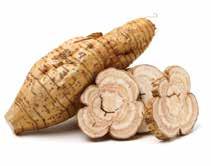
Hailed as a ‘cure-all’ for a range of infections and diseases, echinacea is a Native American plant that stimulates activity across the immune system. Studies have shown its effectiveness in regulating immune response with an increase in the activation of the immune response to fight off germs.
For most of us, what this really means is fewer days out sick with a cold or flu, and milder symptoms.

If you’ve been hunting for elixirs to improve your sleep, you might have come across ashwagandha. As a potent adaptogen, ashwagandha uplifts the body in the face of stress, which can disrupt interaction between the nervous and immune systems, and cause immune dysfunction. With its rejuvenating and anti-inflammatory properties, ashwagandha is also known as ‘Indian ginseng’ and promotes overall health with improved energy and longevity.

Remember the last time you had a stressful week that toppled your body like dominos? You were left lying awake at night. You slept in. You zipped through lunch on a banana and latte. You skipped exercising and ended the day giving in to a craving for chips. The next day you woke up with that achy, a cold-iscoming feeling. This is a prime example of our body’s interconnected, often overworked systems that then have to face infection, invaders, inflammation or toxins. Try these everyday things to help strengthen your early defences against illness and balance your immune system.
The odd night of a restless sleep is one thing—a lot of bad sleeps is another. After a while, the body registers poor sleep as a stressor and begins to overproduce cortisol to get through the day. Chronically high cortisol suppresses other systems, including the immune system. What are some tools that can help you get longer, deeper ‘good’ sleeps? A bedtime routine that creates a sense of calm and a shifting down can make all the difference: putting away screens an hour or two ahead of hitting the pillow, a light yoga session or meditation, relaxation teas, Epsom salt baths, white noise, blackout blinds and even sleep aids.
Going for a good walk every day can do wonders for your immune health. Why? Your body’s muscles and joints are pumping along the lymphatic fluids that collect toxins and send them to lymph nodes and the liver. Deep breathing during exercise or a post-workout massage are other ways to help flush out toxins and de-stress.
Things will always come up that make us feel anxious or upset. We can’t pause stress; we can only set ourselves up to manage it in a healthy way. Too much stress means too much cortisol means a weak immune system.

Now there’s even more reason to cook with garlic. Long used to treat common colds and chest infections, it’s a flavourful way to increase your body’s natural killer cells (that army. With antioxidant phytochemicals such as organosulphur compounds, garlic destroys free radicals that damage membranes.
You’ve probably heard this one before, but it works: to really take care of your immune health, eat your greens and vitamin C. For the greens, kale, spinach and broccoli—those dark greens—are what you’re really after. Citrus fruits give you that hit of sunshine that’s so important in the winter. Chickpeas are a terrific protein, which is key to kicking off an immune response, and great for regulating blood sugar.
Processed and sugary foods can have the opposite effect: by creating inflammation and suppressing the immune system for several hours, they slow down your body’s ability to fight bacteria and illness. (There’s a reason most kids get sick after Halloween!).
When you start to notice signs of feeling stressed (increased heart rate, foggy brain, heaviness in the chest), think about what you can do to offset: go for a walk, eat whole foods, drink water and set yourself up for a good night’s rest. Resist the urges for sugar, coffee or alcohol—they will only worsen inflammation and weaken the immune system.
Daily self-care in all of these ways is your superpower against sickness. Good food, good rest, a bit of movement and those dozycozy evening routines.
Continued on next page
One of this mushroom’s three superpowers is supporting immune health (gut health and longevity are the other two). By stimulating the white blood cells that fight infection and promote immunity to toxins, turkey tail naturally strengthens the health of your immune system.

It’s the spice that gives yellow curry that beautiful golden colour—and it’s been used in traditional Indian foods for centuries for its ability to reduce pain and inflammation, and enhance immunity.
Turmeric’s active ingredient, curcumin, fights the free radicals that damage cell membranes and DNA, and it can even kill harmful cells.

With these superfoods, improving your immune health is just the start. Each brings an array of other health benefits, from better sleep to more energy. And with so many great recipes, it’s easy to incorporate these immune boosters into your daily diet for wellness through cold and flu season and all year round.
 | TURKEY TAIL MUSHROOM
10 | TURMERIC
| TURKEY TAIL MUSHROOM
10 | TURMERIC
per serving


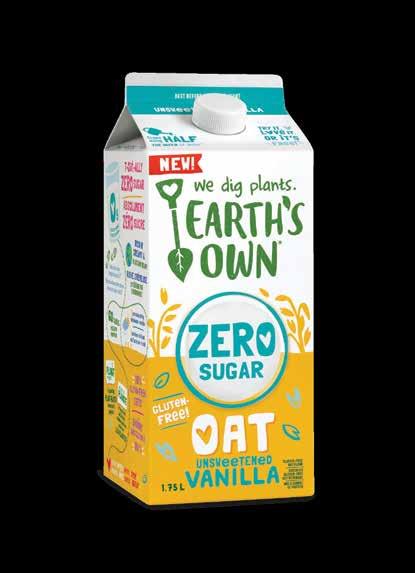


Non-GMO (genetically modified organism) foods and organic foods represent two completely different aspects of food production. Hand-in-hand, and for different reasons, they offer the healthiest choices for you and the planet. Let’s dig a little deeper.
Changing how food tastes, looks and lasts is nothing new. From the time our ancestors started to farm, they enhanced crop traits through a slow, “selective breeding” process. Over time, this resulted in significant, lasting genetic changes, in plants and animals.
Think about dogs: Every size and shape of dog we know today is the result of efforts by humans, over 30,000 years, to domesticate wild wolves by breeding them for certain traits to make them tamer.
Plants grown for food have also become unrecognizable over hundreds of years of trait selection:
• Corn has evolved from a wild grass into the sweet, juicy niblets we love today.

• Bananas, first cultivated about 10,000 years ago in Papua New Guinea, were rounder, less fleshy, and sweet with large, hard seeds.
• Carrots in 10th century Persia and Asia Minor were purple or white with a thin, forked root.
• Peaches, first domesticated about 4,000 BCE by the ancient Chinese, were small and cherry-like, with little flesh and a slightly salty, earthy taste, much like a lentil.
While selective processes are still used, a dramatic breakthrough came in 1973. Two scientists created the world’s first genetically engineered organism when they cut a gene that encodes antibiotic resistance from one strain of bacteria and pasted it into another, transferring that resistance into the other organism.
An Unnatural Process
GMOs are living organisms artificially manipulated in a laboratory through genetic engineering.
Using transgenic techniques, the DNA of one organism is modified with the DNA of another, to create new combinations of plant, animal, bacteria and virus genes that don’t occur in nature or through traditional crossbreeding methods.
The result is an organism that can tolerate herbicides; resist insects, diseases and drought; provide increased nutritional value; or develop certain traits in plants, like potatoes that resist browning.
Nearly all GMOs are used to make animal feed. In human food, they are mostly used in processed ingredients like oils and sugars, preservatives and emulsifiers.
Over 90% of corn grown in North America is GMO.
Want verified non-GMO?
Look for the butterfly label.
A verified non-GMO system supports organic and regenerative agriculture by reducing contamination pressure and protecting the supply of nonGMO seed.
With this technology comes great concern about the impact on our health and ecosystems.
• Long-term impacts of GMOs are unknown. Once released into the environment, these novel organisms cannot be recalled.
• Biotechnology companies own and restrict GMO use, and work to have patented ownership of the food supply. Three chemical companies now control about 60 percent of the world’s seed supply.
• GMOs are a serious threat to farmer sovereignty and national food security.
• Worldwide, over 80% of all GMOs grown are engineered for herbicide tolerance, and use of toxic herbicides has increased 15-fold.
• GMO crops are responsible for the emergence of “superweeds” and “superbugs” which can only be killed with more toxic poisons like 2,4-D (found in Agent Orange).
—Source: Non-GMO Project
The non-profit Non-GMO Project works to build and preserve the non-GMO food supply through education, research and collaboration.
Common GMO crops include corn, soy, cotton, canola, alfalfa, papaya, potato, sugar beets and zucchini.
Organic agriculture is based on the sustainable cultivation of land for food production, with practices that nourish the soil, respect and nurture animals, and care for water resources.
While organic foods may also be non-GMO, not all nonGMO foods are organic. A food can be non-GMO and still be grown using synthetic pesticides and fertilizers.
At Nature’s Fare Markets, we are passionate about local, organic and sustainable ingredients and offer an organic, non-GMO product in every category, whenever feasible. Local, organic and sustainable products are our top priority.
Techniques include crop rotation, companion planting, mulching, green manures, raising animals in a natural environment and the use of natural predators to discourage weeds, disease and pests.
Organic foods are grown without synthetic pesticides, fertilizers, growth hormones, additives, antibiotics, artificial preservatives, irradiation or genetically modified seeds.
Organic farming practices arrived in Canada in the 1950s, influenced by the rise of biodynamic agriculture in Europe and concerns about the rise of chemical pesticide use in the 1940s.
By the 1970s, organizations in six provinces had been established to lobby for government support and to promote organic practices. Certification programs followed and then the National Canadian Organic Standards, backed by government regulation and oversight, were made law in 2009, to ensure that products labeled “organic” are grown by organic farming principles.

Getting Organic certification in Canada is a rigorous process; it can take a manufacturer or producer up to three years to prove they meet the standards of care required by the Canadian Food Inspection Agency.

Farms must undergo annual inspections and keep records to trace every certified organic product back to the farm on which it was produced.
SOURCES
https://www.thecanadianencyclopedia.ca/en/article/organic-agriculture
https://organicbc.org
https://organicfederation.ca/canadian-organic-standards/ https://www.dal.ca/faculty/agriculture/oacc/en-home/about/organic-canada.html
https://chfa.ca/en/
https://www.nongmoproject.org
https://www.thecanadianencyclopedia.ca/en/article/genetically-modified-foods https://croplife.ca/field-notes-gmo-foods/
https://www.sciencealert.com/fruits-vegetables-before-domestication-photosgenetically-modified-food-natural https://sitn.hms.harvard.edu/flash/2015/from-corgis-to-corn-a-brief-look-at-thelong-history-of-gmo-technology/

“Regularly add collagen to your diet.” Why?

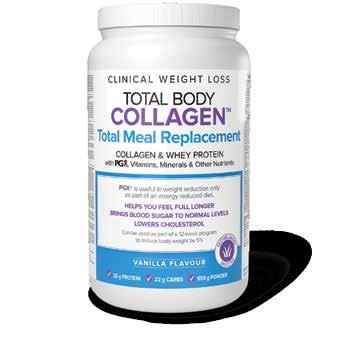
When it comes to feeling good and looking good, I am going to share my secret weapon… it is called Total Body Collagen™. Collagen hydrates our skin, reducing wrinkles and giving us that plump youthful glow, healthy hair, and skin.

 – JULIE REIL , MD and Beauty Expert
– JULIE REIL , MD and Beauty Expert




Indulge in a weekend favourite, every morning. These waffles are hand-made using a unique blend of clean ingredients, and real fruits and vegetables. Made with love and care, these breakfast delights are all about nourishing your body while satisfying your taste buds.


This is the cozy side of fall, where creamy latte meets refreshing smoothie with the added benefits of vegan protein. Made with Say When Dirty Chai, oat milk, banana, chia seeds, vanilla and cinnamon.
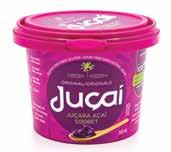
Indulge in a mouthwatering sorbet that not only delights your taste buds but also contributes to the preservation of Brazil’s precious Atlantic forests. Every spoonful is bursting with flavour and enriched with powerful antioxidants.


Crunchy, munchy, chewy, savoury or sweet, these snacks are all the good and none of the bad. They’re free of gluten, preservatives, white sugar, dairy and fillers. We are loving these plant-powered and kid-approved cookies and squares.
PROTECT OUR LAND
These handcrafted truffle gnocchi from Favuzzi are a culinary adventure. Delicate potato dough is perfectly blended with black truffle for a luxurious taste sensation. You won’t want to miss these!

When you bring your own bag, you’re helping to protect and restore habitat right here in BC. So far, our program has raised $126,267.17


